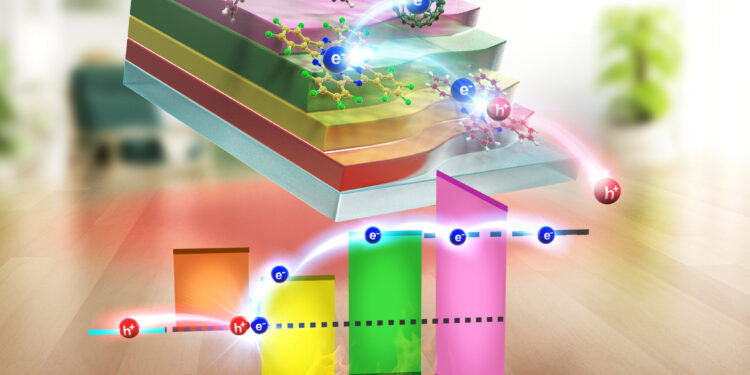This new organic thermoelectric device can convert ambient heat, which is abundant in residential environments and was previously not considered a possible energy source, into usable electrical energy. Since no temperature gradient is required, i.e., no cooling unit is needed, the device can be compact. Credit: Kyushu University/Chihaya Adachi
Researchers have developed a new organic thermoelectric device that can harvest energy at room temperature. Although thermoelectric devices have many applications today, there are still obstacles to their full use. By combining the unique capabilities of organic materials, the team has successfully developed a framework for generating thermoelectric energy at room temperature without any temperature gradient.
Their results were published in the journal Nature Communications.
Thermoelectric devices, or thermoelectric generators, are a series of energy-generating materials that can convert heat into electricity as long as there is a temperature gradient, that is, one side of the device is hot and the other side is cold. These devices have received significant research and development attention because of their potential usefulness in recovering waste heat from other energy production methods.
Perhaps the best-known use of thermoelectric generators is in space probes such as the Curiosity rover or the Voyager probe. These machines are powered by radioisotope thermoelectric generators, where the heat generated by radioactive isotopes provides the temperature gradient needed for thermoelectric devices to power their instruments.
However, due to issues such as high production cost, use of hazardous materials, low energy efficiency, and the need for relatively high temperatures, thermoelectric devices remain underutilized today.
“We were looking for ways to make a thermoelectric device that could harvest energy from room temperature. Our lab focuses on the utility and application of organic compounds, and many organic compounds have unique properties that allow them to easily transfer energy between themselves,” says Professor Chihaya Adachi of the Center for Organic Photonics and Electronics Research (OPERA) at Kyushu University, who led the study.
“A good example of the power of organic compounds can be found in OLEDs or organic solar cells.”
The key was to find compounds that work well as charge transfer interfaces—that is, can easily transfer electrons between them. After testing various materials, the team found two viable compounds: copper phthalocyanine (CuPc) and copper hexadecafluorophthalocyanine (F16(CuPc).
“To improve the thermoelectric property of this new interface, we also incorporated fullerenes and BCP,” Adachi continues. “These are known to be good facilitators of electron transport. Adding these compounds significantly improved the power of the device. In the end, we obtained an optimized device with a 180 nm layer of CuPc and 320 nm of F16CuPc, 20 nm fullerene and 20 nm BCP.
The optimized device had an open circuit voltage of 384 mV, a short circuit current density of 1.1 μA/cm2and a maximum power of 94 nW/cm2Moreover, all these results were obtained at room temperature without the use of a temperature gradient.
“There has been considerable progress in the development of thermoelectric devices, and our proposed new organic device will certainly help move things forward,” Adachi concludes.
“We would like to continue working on this new device and see if we can optimize it further with other materials. We could even achieve a higher current density if we increase the surface area of the device, which is unusual even for organic materials. It just shows that organic materials have incredible potential.”
More information:
Organic thermoelectric device using charge transfer interface as charge generation by thermal energy harvesting, Nature Communications (2024). DOI: 10.1038/s41467-024-52047-5
Provided by Kyushu University
Quote:Organic thermoelectric device can harvest energy at room temperature (2024, September 19) retrieved September 19, 2024 from
This document is subject to copyright. Apart from any fair dealing for the purpose of private study or research, no part may be reproduced without written permission. The content is provided for informational purposes only.



